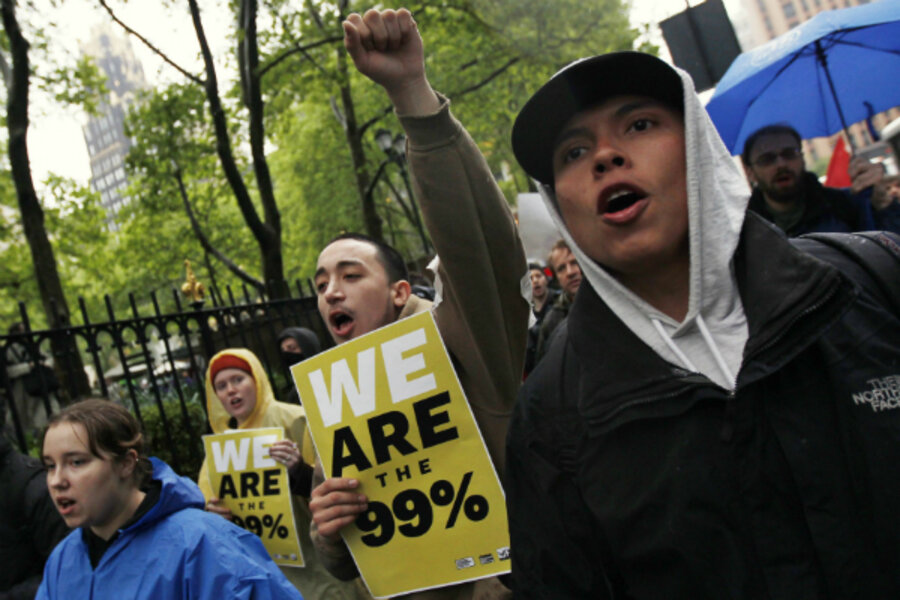Occupy movement seeks new recruits. In New York, it found some.
Loading...
| New York
April showers didn’t bring May flowers this year – they bloomed early – but May Day did bring some new people into the Occupy Wall Street movement.
The Occupy movement's May Day marches and demonstrations across the country were intended in part to revive the movement, which had lost some momentum over the winter months, and gain new support.
"What they need to do is showcase the movement as a relevant voice,” says Catherine Wilson, a professor of political science at Villanova University in Villanova, Pa. “They are trying to reignite the movement by partnering with like-minded groups to effect change.”
Despite early morning rain, protesters started the day in midtown’s Bryant Park, in a style reminiscent of last fall’s encampment in Zuccotti Park.
A schedule of marches, gatherings, events in parks throughout the city and protests outside of corporations and banks meant that there were many opportunities to join in. Occupy groups used social networks like Twitter and Facebook, as well as old-fashioned pamphlets, to publicize the day’s events.
For young people, the day was a chance to join the movement – even if it meant missing school.
“There is the realization that we need to take the country back from the corporations,” says Jeremy Cohen, 14, who, together with two friends, his mom, and a friend’s mom, came in from Princeton, N.J., for the May Day protests. The three eighth-graders stood behind an Occupy banner that Jeremy had used his birthday money to buy online.
As they told a reporter why they took the day off from school to be part of the protest, a police officer told them that they weren’t allowed to stand on the sidewalk. They kept walking.
Jeremy, who visited Zuccotti Park last fall, convinced his friends to become involved over the winter. He said most of his teachers were supportive of his skipping school to join the protests, and some said they wished they could go, too.
“I agree with almost everything that Occupy Wall Street is promoting,” says Jeremy Taylor, also 14. “It’s great to be part of something larger than yourself.”
About 40 students from Bard High School Early College in Queens came to Madison Square Park as part of a field trip. The students and their teachers gathered in the park, where teach-in circles formed on topics such as classical philosophy and nonviolence.
“We are learning about strikes and inequality in school, so this was especially relevant,” says Macella Geffard, 14, who had just finished a unit on the progressive movement in her American history class. “It’s crazy to see how history repeats itself.”
“I thought we would have solved our issues by now,” says her classmate, Jordan Hampton, 14.
Both students cited the rising costs of college tuition as their main concern.
“Education is the most important issue to me,” Macella says. “I have to pay attention soon, since I am going to need to pay for college.”
Some people, while not new to the movement, were new to the one in New York.
Bradley Shields has been active in Occupy Honolulu. Because he was visiting family in New York this week, he decided to bring some of the “aloha spirit” to Occupy Wall Street, which he says is the center of the Occupy movement, because Wall Street and many corporations are based here.
“It’s inspiring to see so many people on a cold, rainy weekday,” he says. “I can’t wait to relay the news to Hawaii,” where he has lived for the past 40 years.
Ben Neiditz and Will Dean came up from Philadelphia for the day. Despite a few visits to the Occupy Philadelphia protests, they wanted to be in New York for May Day. Both took the day off from their jobs at the Art Museum at the University of Pennsylvania.
“This is where the movement started, and this is where Wall Street is based,” says Mr. Neiditz.
“I saw an article in Bloomberg News about private security forces banding together to guard banks and corporations today, so, I figured, if they were taking it seriously, so should I,” said Mr. Dean.
Marcarena J, a visual artist from Chile, joined the movement to offer free haircuts in Union Square. “Today is a day for workers, and workers need haircuts,” she says.
For others, the day was a way to learn more about the Occupy movement, despite some misgivings.
“I'm all for unions, so I figure another body out in support is a good thing, and also it just seems like fun,” says Jesse, contacted by e-mail in Portland, Ore.
Jesse, who asked that he be identified only by his first name, plans on attending what he calls the “permitted" International Workers Day parade in downtown Portland and the roving dance party, but will stay clear of less officially sanctioned events.
“I'm curious about the Occupy events but also wary and not too interested in being involved in any police-type conflicts,” he says. “Especially since I'm fuzzy on the reasoning behind a lot of things.”







